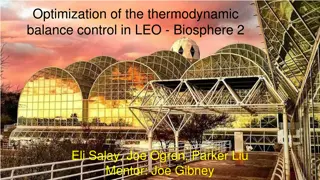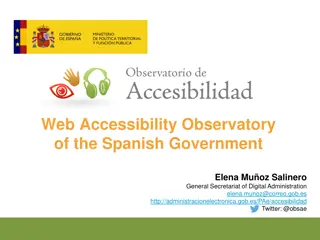Insights from Orbiting Carbon Observatory-2 (OCO-2) on Global Carbon Cycle
"Orbiting Carbon Observatory-2 (OCO-2) offers precise measurements to understand sources and sinks of CO2 in the atmosphere, providing valuable data on carbon uptake by plants and global carbon emissions. OCO-2's findings shed light on the impact of extreme climate events like droughts and fires on the ecosystem and regional carbon budgets, highlighting the need for continuous monitoring and mitigation efforts to combat climate change."
Download Presentation

Please find below an Image/Link to download the presentation.
The content on the website is provided AS IS for your information and personal use only. It may not be sold, licensed, or shared on other websites without obtaining consent from the author.If you encounter any issues during the download, it is possible that the publisher has removed the file from their server.
You are allowed to download the files provided on this website for personal or commercial use, subject to the condition that they are used lawfully. All files are the property of their respective owners.
The content on the website is provided AS IS for your information and personal use only. It may not be sold, licensed, or shared on other websites without obtaining consent from the author.
E N D
Presentation Transcript
Orbiting Carbon Observatory-2 (OCO-2) Vivienne Payne (OCO-2 PS), Abhishek Chatterjee (OCO-2 DPS), OCO Science Team
The relentless rise of CO2 in our atmosphere OCO-2 provides measurements with the accuracy and precision required to quantify the sources and sinks that control the growth and variability of CO2 in our atmosphere. The stable, long-term, global, high-quality data record from OCO-2 makes it unique among all greenhouse gas sensors. The OCO-2 instrument and spacecraft remain in excellent health! 9 / 3 0 / 2 0 24 2
SIF shows where and when carbon uptake by plants is occurring Northern Hemisphere Winter Northern Hemisphere Summer Figure: Maps of SIF in March (left) and July (right) 2021 showing strong growth in July over the northern hemisphere and strong growth in the tropics and southern hemisphere in March. Measurements of solar induced fluorescence (SIF) provide direct information on carbon uptake by plants. OCO-2 shows the spatial distribution and how this is changing in time. SIF is an excellent complement to XCO2 for constraining carbon fluxes 3 9/30/2024
Taking stock of national contributions to global CO2 from space OCO-2 contributions to the Global Stocktake under the Paris Agreement https://www.jpl.nasa.gov/news/nasa-space-mission-takes-stock-of-carbon-dioxide-emissions-by-countries Byrne et al., 2023 This map shows mean net emissions and removals of carbon dioxide from 2015 to 2020 using estimates informed by NASA s OCO-2 satellite measurements. Countries where more carbon dioxide was removed than emitted appear as green depressions, while countries with higher emissions are tan or red and appear to pop off the page. Credit: NASA s Scientific Visualization Studio 4
Australian drought and fires, 2019-2020 Extreme climate events play an outsize role in the global carbon cycle OCO-2 has shown that carbon flux anomalies caused by extreme Australian drought and fires in 2019 2020 were larger than the country s annual fossil fuel emissions. Will increasingly frequent extreme climate events in future years cause a tipping point in the regional carbon cycle? 5 Byrne et al., 2021
Summary OCO-2 has transformed understanding of the carbon cycle Especially in key regions, such as the tropics and high latitudes,where in situ obs are sparse OCO-2 has revealed the outsize impact of extreme climate events on ecosystem health and regional carbon budgets Flood, drought, fires OCO-2 is a key element of a greenhouse gas observational network to Enhance scientific understanding Inform climate mitigation efforts, assess mitigation goals
QUESTIONS? Email: vivienne.h.payne@jpl.nasa.gov OCO-2 Webpage - https://ocov2.jpl.nasa.gov/
Publication statistics BACKUP 8























